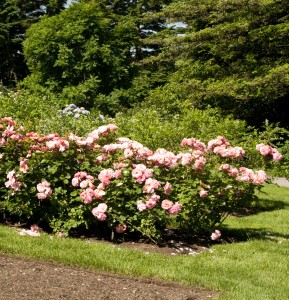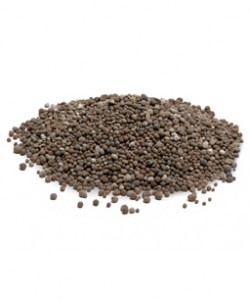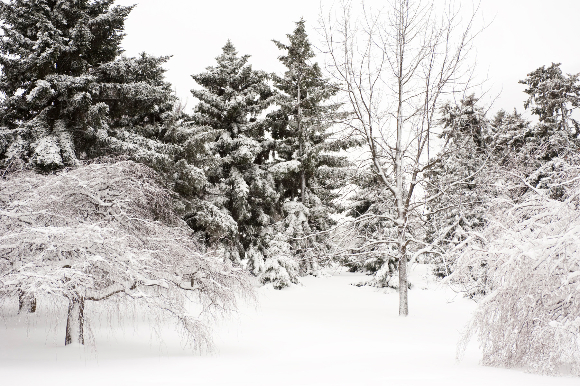Storm Clean-Up 101: Coastal Flooding and Soil
Posted in Around the Garden, Gardening Tips on February 19 2013, by Sonia Uyterhoeven
Sonia Uyterhoeven is the NYBG‘s Gardener for Public Education.
 Salt damage after coastal storms is not uncommon. Coastal gardeners will notice an appreciable amount of burn on their lawns and their ornamental beds after a storm, damage which will generally be more prominent on the windward side of the garden. Foliage will look desiccated and brown and you will discover that leaf buds have either been killed or are slow to leaf out in the spring.
Salt damage after coastal storms is not uncommon. Coastal gardeners will notice an appreciable amount of burn on their lawns and their ornamental beds after a storm, damage which will generally be more prominent on the windward side of the garden. Foliage will look desiccated and brown and you will discover that leaf buds have either been killed or are slow to leaf out in the spring.
If salt damage has affected large areas of your garden and plants are wilting, growth is stunted, or buds are slow to break in the spring, then it is worth getting a salinity test for your soil. It is possible that the roots were damaged from increased levels of salt water, or the soil has excess adsorbed sodium which is preventing the plant from taking up nutrients and water.
Last week we discussed how to take a soil sample in your garden, while this week we will focus on gardeners who were affected by Super Storm Sandy. For coastal gardeners who experienced flooding, requesting an extra test for soil salinity measurements will be important–it measures the amount of soluble salts in the soil. There will most likely be an additional charge for this test, but it is usually fairly reasonable, with most laboratories generally performing an Electrical Conductivity (EC) test to determine the amount of soluble salts.
If soil salinity is a problem, then your garden may need to be flushed with water to move the salt water from the root zone to deeper in the ground, where it can dissipate without affecting plant growth. Leach the garden with two to three inches of water twice a week after a coastal storm; if there has been significant rain with the storm, it may not be necessary. Some soil experts recommend leaching the soil with anywhere from six to 12 inches of water, but these are extreme measures and it is important not to super-saturate your garden, otherwise you will suffocate plants.

If you get your EC test back and the numbers are off the scale, then it will be worth getting another soil test and having the adsorbed sodium tested. Sodium is tested with a Sodium Adsorption Ratio (SAR) or an Exchangeable Sodium Percentage (ESP) test.
If there is an excess of adsorbed sodium in the soil from either repeated exposure to salt sea spray, or from an extended period of flooding, then the standard remedy is to broadcast gypsum on the area and water it in with two to three inches of water. The chemistry behind it is complicated, but the calcium in the gypsum will essentially replace the sodium in the soil. The sodium test is important, as it will determine if gypsum is necessary and how much to use.

I have spoken to a number of experts and they have mixed feelings regarding the use of gypsum. Some are not convinced of its effectiveness and too much gypsum is unhealthy for the soil. Humic acid, one of the constituents of compost, is an environmentally-friendly and more effective way of combating excessive levels of sodium. Found often at garden centers, humic acid pulls out and binds the sodium so that it doesn’t interfere with healthy plant growth. It is also wonderful for feeding soil micro-organisms. You don’t have to worry about negative effects on your soil with this product, either, so why not give it a try?
Sea water surges generally do not create a lasting problem for soils–the water rises and subsides quickly. It turns into a problem, however, when the ground is submerged for an extended period of time; some areas were left this way for up to a week after Sandy passed. It is not only the salt content that is a problem, but also compaction. Water is heavy, and its weight is harsh on soil structure. If you have an area that was underwater for an extended period of time, apply a layer of compost to the area this spring (one inch for lawns, one to two inches for established beds).
As I am writing this, many of you are inundated with several feet of snow from the recent mega-snowstorm Nemo. And while you may or may not enjoy being surrounded by feet of snow, it’s actually a blessing as far as your garden is concerned. Not only is snow a wonderful insulator, protecting sensitive young buds and foliage from winter burn, but it is also great at pulling salt out of the soil. Mother Nature may have dumped a whole load of salt on your garden in October, but now she is removing it in the way she knows best.

Beyond salt, flooding can sometimes introduce sewage and a variety of other contaminants into the soil, including lead, which some laboratories test for while doing soil tests. Other times, heavy metal tests can be extremely expensive. Of course, they may not be necessary unless you are planning on growing edible crops. Many areas that were flooded during the last super storm were not plagued by sewage runoff, making it possible that a one-time event may not have caused significant damage.
Below is a list of several Cooperative Extensions and laboratories that are available to homeowners in the New York area:
The Connecticut Agricultural Experiment Station
Gypsum image by Fine Gardening.


We live on the water in Merrick, New York. Our back and front lawns were flooded with about 3′ of salt water. We have several “specimen” trees such as a large weeping copper beech tree, a huge weeping sargeant hemlock (about 10-12 feet high and 20 feet wide), a huge weeping chamaecyparis nootkatensis (about 25-30 feet high), and a huge weeping white pine, along with coral bark maples, and crepe mrytles, as well as, a weeping blue atlas cedar and weeping birch.
The sargeant hemlock lost all its green pines, although the wood has a green hue to it. The weeping blue atlas cedar lost all its pines, began to form new growth, but it has all died. The weeping birch grew new leaves, but they too are drying up and dying.
The weeping copper beech (a tree closest to the canal), I thought for sure would die, but it bloomed beautifully. However, I am concerned that, in some spots, its leaves seem to be browning and shriveling. The Nootkatensis is brown in some spots, but overall remained green. I’m also concerned about that tree for the same reasons as the cooper beech.
We have not had a salinity test and wonder if it is too late. Our tree expert seems to think we can plant new trees, but have to replace the soil going down about 6-8″. I don’t know what he will say about the trees mentioned above.
We didn’t do do anything specific for the trees except put try to water them as often as possible for a few hours, and put down gypsum around all the trees and shrubs shortly after the storm, because we had been concentrating on rebuilding the inside of our home which sustained 5′ of water.
Do you have any specific advice regarding especially the Nootkatensis and the weeping copper beech? If you do, I would deeply appreciate it. I am thanking you in advance for any advice you can give us, I remain, Very truly yours, Judith Stone